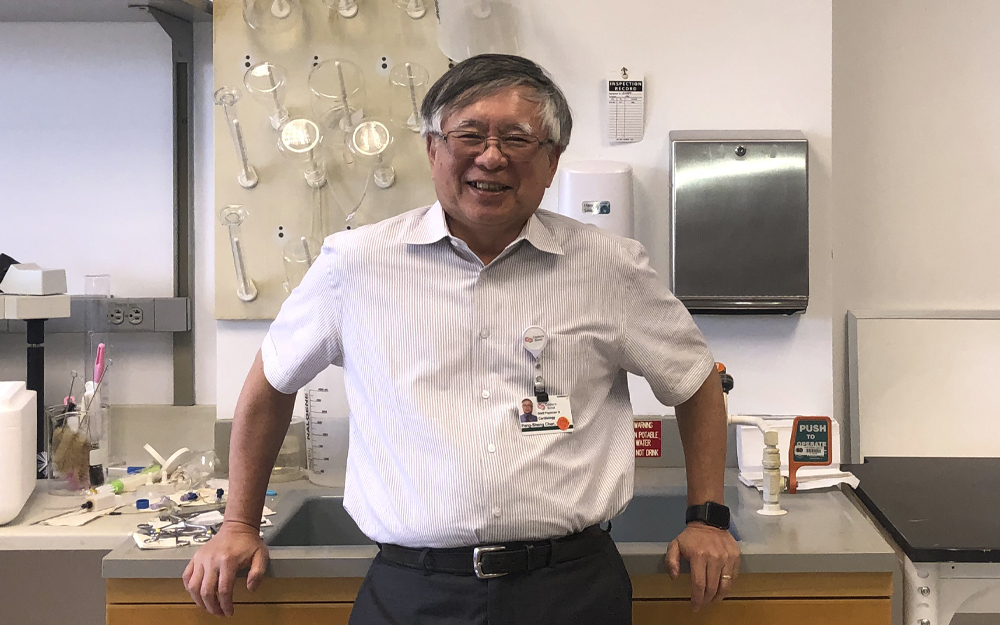Cedars-Sinai Blog
Faces of Cedars-Sinai: Dr. Peng-Sheng Chen
Jul 20, 2021 Agata Smieciuszewski

Meet Dr. Peng-Sheng Chen, a cardiologist at Cedars-Sinai!
When Dr. Chen, the Burns and Allen Chair in Cardiology Research, was making the move to Los Angeles from San Diego in 1992, he was glad to see an opening for a faculty position at Cedars-Sinai.
We talked to Dr. Chen about his journey from Taiwan to Cedars-Sinai and his career in electrophysiology.
What is electrophysiology, and what got you interested in pursuing it as a career?
Dr. Peng-Sheng Chen: My field of study is cardiac arrhythmia, so heart rhythm disorders. In medical school, we were fortunate to be able to be the first in doing a surgery to cure an arrhythmia called Wolff-Parkinson-White syndrome. It was very exciting to be able to treat and cure the arrhythmia.
In Discoveries: Heart Rhythm Revelations
What is the most exciting or surprising part of what you do?
PSC: Between 1992 and 2007, when I was here for 15 years, the entire field of heart rhythm care had undergone a major revolution, which included—most importantly—the development of radiofrequency tools to cure arrhythmia with catheters. We were part of that revolution and significantly expanded the service to patients.
It was also very exciting when the defibrillator that can be implanted under the skin was developed, which meant we don't need a surgery to crack open the chest to implant those devices. It's very exciting that almost any of the arrhythmias suddenly became curable!
"People interested in medicine have to be interested in people and dealing with people's problems. I felt that I have that kind of interest in communicating and dealing with people's issues."
Where did you grow up?
PSC: I grew up in Taiwan. I moved here after medical school and serving in the military when I was 27.
What would you consider the most challenging part of what you do?
PSC: Balancing taking care of patients, educating students and pursuing medical research. All three of them demand a significant amount of time.
What made you interested in pursuing medicine? Was that something that you always knew you were going to do?
PSC: Yes, I knew since I was in high school. People interested in medicine have to be interested in people and dealing with people's problems. I felt that I have that kind of interest in communicating and dealing with people's issues.
Is there another profession that you could see yourself doing if you hadn't gone down the medical path?
PSC: I did think seriously about being an engineer—especially electrical engineer. I was fascinated by all the machines involved. But when you practice cardio-electrophysiology, you're surrounded by many gadgets and machines.
I think a lot of people in my trade are born engineers. You can see the heart as plumbing and electricity. We are interested in the electrical part of the heart.
Which living person do you most admire?
PSC: I most admire my mentor from when I was in cardiology training. His name is Raymond Ideker. I was in his research lab for two years and not only learned how to do research, but I also learned how to be a person.
What do you consider your greatest achievement?
PSC: I always enjoy working with young people. I have personally trained a lot of research fellows and clinical fellows, and many of them have become trainers, mentors and professors as well. That's my greatest achievement—the perpetuation of knowledge and skills to the next generation.
What do you like to do when you're not at work?
PSC: My wife and I enjoy hiking. We use our weekends to hike around the beautiful mountains in Southern California, with striking views and great weather. We also enjoy going to Descanso Gardens and the Huntington Library. Southern California has many beautiful things to offer— it truly is a gift to live here.


